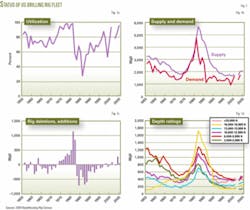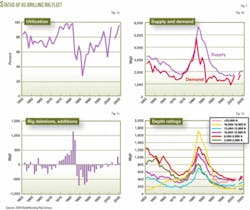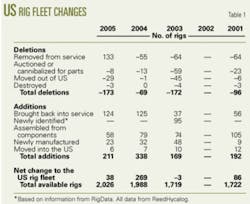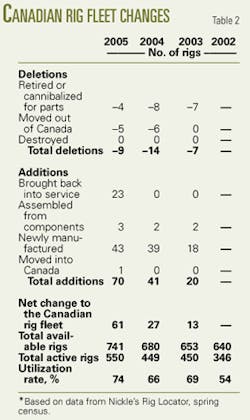ReedHycalog: US fleet activity up 15% from 2004
According to the annual ReedHycalog rig census, utilization of the North American rig fleets increased substantially from 2004: 15% in the US and 8% in Canada. ReedHycalog president John Deane accurately forecast the US increase a year earlier, during his presentation on Sept. 24, 2004 (OGJ, Oct. 25, 2004, p. 49).
The 52nd annual rig census was compiled by ReedHycalog, a division of Houston-based Grant Prideco Inc. and released Oct. 10. The survey was initially scheduled for presentation in late September 2005 at the IADC annual conference in Galveston, but was postponed due to Hurricane Rita.
The rig census is based on rig ownership and activity (“turning to the right”) during a 45-day period (May 4-June 17, 2005).
US rig fleet
US fleet utilization rose to 95% in 2005, from 84% in 2004. The 2005 utilization rate is 21% higher than the 52-year mean, but still falls short of the 98% utilization reported in 1981 (Fig. 1a).
The supply of US-based rigs increased only 2% in 2005, to 2,026 rigs, up from 1,988 rigs in 2004 (Fig. 1b). The net increase to the fleet is 38 rigs in 2005, far less than the 269 rigs added in 2004 (Fig. 1c).
Nearly all US rigs are owned by drilling contractors (97%, 1962 rigs); operators control the remaining 3%.
Rigs capable of drilling to 6,000-9,999 ft comprise the largest portion of the US fleet (23%, 474 rigs), followed by rigs able to drill to 10,000-12,999 ft (23%, 472 rigs), a reversal from last year (Fig. 1d). The next most common are rigs capable of drilling deeper than 20,000 ft (19%, 375 rigs), followed by rigs able to drill to 13,000-15,999 ft (15%, 311 rigs).
The supply of deep-drilling rigs (greater than 20,000 ft) has dropped by 12% (49 rigs) since the 2004 rig census, the largest decline of any depth category.
Table 1 delineates the trends in rig deletions and additions in the US drilling fleet, according to the 2005 census.
Land rig utilization trends vary regionally across the US:
• North Rockies, 99%.
• South Rockies, 98%.
• Midcontinent, 98%.
• Permian basin, 97%.
• Arkansas-Lousiana-Texas, 97%.
• Gulf Coast, 95%.
• Southeast, 92%.
• California, 85%.
• Northeast, 83%.
• Alaska, 67%.
The 2005 census indicates that 1,813 land rigs are available, up from 1,736 in 2004 (4% increase). 2005 utilization of US land rigs was 95%, up 9% from 2004.
Rig fleets increased in the midcontinent (308 rigs), up 5 from 2004; in Arkansas-Louisiana-Texas (304 rigs, up 46); in the southern Rockies (241 rigs, up 37); in the northern Rockies (98 rigs, up 19); and in the northeastern states (149 rigs; up 18).
In contrast, rig fleets dropped along the Gulf Coast (327 rigs, down 18 from 2004); in the southeastern states (256 rigs, down 40); in the Permian basin (256 rigs in 2005, down 9); in California (60 rigs, down 9); and in Alaska (27 rigs, down 1).
Canadian rig fleet
The ReedHycalog census began covering the Canadian rig fleet in 2003. Calgary’s Nickle’s Rig Locator provided the data for 2002-05. The total number of available rigs has increased to 741 in 2005, up from 680 in 2004, a 9% increase (Table 2).
According to the census, the fleet includes 694 land rigs, 35 coiled tubing rigs, and 6 offshore rigs (2 jack ups, 2 fixed platforms, 2 semisubmersibles).
Newly manufactured rigs, in particular, contribute to the increasingly higher quality fleet (Table 2).
The majority of the Canadian fleet (76%, 560 rigs) is capable of drilling to less than 10,000 ft. The largest share (49%, 360 rigs) is rated to drill to depths of 6,000-9,999 ft. Another 200 rigs (27%) are rated to drill from 3,000-5,999 ft. The remaining 24% of the fleet can drill deeper than 10,000 ft.
Offshore rig fleets
For the second year, ReedHycalog worked with ODS-Petrodata in summarizing data on the mobile offshore rig fleet. The count did not include fixed drilling platforms or inland drilling barges.
In 2005, the global offshore rig fleet included 641 drilling rigs, down 32 rigs (nearly 5%) from 2004. The 2005 census includes 375 jack ups (down 10), 156 semisubmersibles (down 6), 44 drilling barges (down 8), 34 drill ships (down 6), 24 drilling tender-assist drilling units (down 3), and 8 submersibles (down 1).
According to the survey, utilization of offshore drilling units was 85% in 2005, up from 73% in 2004. Depth ratings for offshore rigs were not recorded in the 2005 census. ✦
RIG CENSUS DATA from 1955-2005 can be downloaded from the Grant Prideco web site, at http://www.grantprideco.com/rhrigcensus/2005censushistory.xls.



